A CV or resume is important for a Java developer, as it serves as a professional representation of their skills, qualifications, and experience related to programming. It is required by employers when applying for a job and demonstrates the candidate’s commitment to their career. A well-crafted CV can help them stand out among other applicants and showcase their career progression over time.
Additionally, a resume can be customized to specific job opportunities to highlight their relevant experience and expertise in the field.
In this article, we will be discussing:
- The most effective resume format for a Java Developer
- Overview of the essential sections that should be incorporated
- Strategies to successfully navigate the hurdles presented by Applicant Tracking Systems (ATS)
- Practical do’s and don’ts for writing a resume for
Choose an Effective Format for the Resume
Once you are ready to write your resume, the next thing you need to do is choose a suitable format. Three formats are most commonly used, which are:
Reverse-chronological format
A reverse chronological format is a type of resume layout that presents the candidate’s work experience, starting from the most recent job and then moving backward in time. In this format, the candidate’s most recent work experience is listed first, followed by previous positions in reverse order, with emphasis on the job title, company name, dates of employment, and key accomplishments or responsibilities. This format is commonly used as it provides a clear and easy-to-follow timeline of the candidate’s work history, highlighting their most recent and relevant experience at the beginning of the resume.
Functional format
A functional format is a type of layout that emphasizes the candidate’s skills, qualifications, and achievements rather than their work history in chronological order. In this format, the candidate’s skills, abilities, and accomplishments are grouped under relevant skill-based sections, while the work experience is listed after the skills section, often with less detail.
This format is particularly useful for job seekers who have gaps in their work history, are changing careers, or want to highlight their skills and achievements more prominently. It allows the candidate to showcase their abilities and expertise first, rather than focusing solely on their work history, making it a strategic option for those who want to highlight their transferable skills and qualifications.
Hybrid or combination format
The hybrid format is a type of layout that combines elements of both the reverse chronological and functional formats. In a hybrid format, the candidate’s work experience is listed in reverse chronological order, providing a timeline of their employment history, while also featuring separate sections that focus on the candidate’s skills, achievements, or qualifications. These skill-based sections may be organized by themes, such as technical skills, leadership abilities, or industry expertise, and provide a way for the candidate to emphasize their relevant strengths and accomplishments.
The hybrid format offers customization and flexibility, allowing the candidate to effectively showcase both their work experience and their skills to align with their career goals and the requirements of the job they are applying for.
The reverse chronological format is usually the best option, as it features recent work history first.
Essential Sections of a Resume
The main sections of a Java developer’s resume are:
A personal header is the first thing that catches any potential employer’s attention, and it should contain your name and personal details. This section should not include the term resume or CV and have a font size of between 16-20 points. Middle names should not be written in full; for example, “David Cornelius Jones” should be written as “David C. Jones”.
The details to be included in a professional header include:
- Your name: Your name as it appears on your identification documents
- Phone number: Use the appropriate dialing codes for international numbers.
- Professional email address: This email address usually includes your first and last names. Anything else will be considered unprofessional.
- Residential address: You do not need to provide specific details. A general location will suffice, especially when the potential employer is overseas.
EXAMPLE
Amanda
Phone: 808-242-7291
Email: amandarodriguez@gmail.com
Florida
Attractive profile title
Your profile title should be your last job, even when applying for a senior position. Your potential employers will likely verify this information, so be honest about it. You may have some creative freedom, but never intentionally misrepresent information. The objective is to make your profile title stand out; typically, this means using a font size of 14–16 points for it.
EXAMPLE
Senior Java Developer.
Interactive personal statement
A personal statement is a brief introductory paragraph that highlights the candidate’s professional profile, skills, and career goals. It serves as a summary of the candidate’s key qualifications and provides a compelling introduction to capture the attention of potential employers.
A personal statement can be of two types: a summary statement or an objective statement.
Summary statement
A summary statement is a concise section that provides an overview of the candidate’s qualifications, skills, and accomplishments. It is beneficial for job seekers who want to quickly capture the attention of potential employers and make a strong impression. It is particularly effective for mid-career professionals, career changers, or those applying for senior roles. A well-crafted summary statement can help a candidate stand out from the competition and position themselves as a top candidate for the position.
EXAMPLE
Web developer with 5+ years of working experience in developing and designing user interfaces, testing, debugging, and training staff within eCommerce technologies. Proven ability to optimize web functionalities that improved data retrieval and workflow efficiencies.
Objective statement
An objective statement is a concise statement that outlines a candidate’s career goals, aspirations, and motivations. It is typically positioned at the beginning of the CV or resume and serves as a brief introduction to the candidate’s professional profile.
Objective statements are often utilized by entry-level job seekers or those who are transitioning into a new field and want to highlight their career goals and motivations for pursuing a particular job or industry. They can also be useful for candidates who are targeting a specific job or industry and want to convey their enthusiasm and alignment with the position. A well-crafted objective statement should be specific, concise, and tailored to the job or industry being targeted, clearly stating the candidate’s career aspirations.
EXAMPLE
A passionate and goal-oriented Java developer dedicated to increasing website productivity and boosting consumer interaction. I work well with others, making me an asset to existing teams.
Professional experience
The work history section is a segment that provides a detailed overview of a candidate’s past employment experiences. It typically includes information such as the candidate’s job titles, employers, dates of employment, and a description of the tasks, responsibilities, and achievements in each role. The work history section serves as a chronological record of the candidate’s professional background and provides potential employers with insight into the candidate’s relevant work experience and skills.
There are three main methods employed in writing about professional experience:
STAR method
The star method is the most popular, as it allows both projects and outcomes to be displayed simultaneously. STAR is an abbreviation for Situation, Task, Action, and Result.
EXAMPLE
Customer Service Coordinator | June 2017-Present
Bradley Insurance | Dayton, Ohio
- Used my role as a home insurance agent to identify customer turnover (Situation and task combined here)
- Developed a digital survey to collect data from existing customers (Action)
- Worked with agency president, which led to a 20% increase in customer satisfaction (Results)
Framing points method
The framing point method makes your resume more readable by dividing your professional experience into bullet points. The shorter your points are, the easier it is for potential employers to read.
EXAMPLE
- Improved productivity of the company by creating a script that runs non-stop without any errors
- In collaboration with a team, I launched a website free of bugs with a daily view capacity of more than 20 million.
- Led the IT department’s quality control team, which reduced customer complaints by 90% in three months while improving website efficiency.
Grouping and highlighting method
Grouping and highlighting your experience sorts it into related categories and highlights keywords that potential employers seek. You can convey all pertinent information without becoming repetitive or tiresome while still making an impression on potential employers by keeping your experience brief.
EXAMPLE
- Revamped web application security applications improving hacker security from 0.016% to 3.6%
- Designed and developed a user-friendly website, increasing customer purchases by 35%
- Trained over 50 staff members in internal web functions
- Fixed bugs from existing websites and implemented enhancements, improving both efficiency and speed
tip
For the employer’s convenience, the description should be presented in bullet points, and be easy to read. Avoid wordy sentences and excessive use of punctuation, and maintain consistency throughout. In addition, make sure the resume is tailored to the job, using keywords from the job description.
Education details
The educational details section typically includes information about the candidate’s educational qualifications, such as their degrees, certifications, and relevant coursework. This section is particularly relevant for entry-level job seekers or those with limited work experience who may need to emphasize their educational background as a demonstration of their qualifications.
Some of the information you need to include are:
- Program or course of study
- Name of the institute
- Location of the institute
- Course duration, ie., enrollment date to graduation.
EXAMPLE
Bachelor’s in Computer Science
Massachusetts Institute of Technology, Cambridge, MA
Dec’ 14 – Mar ’18
Technical skills
This section highlights the candidate’s technical skills related to Java programming, such as programming languages, frameworks, libraries, databases, and other relevant tools or technologies.
EXAMPLE
Technical skills
- Java Programming, including proficiency in object-oriented programming (OOP), Java syntax, libraries, and frameworks.
- Java EE (Enterprise Edition) such as Servlets, JSP (JavaServer Pages), JPA (Java Persistence API), EJB (Enterprise JavaBeans), and JMS (Java Message Service).
- Spring Framework, including Spring MVC, Spring Boot, Spring Data, and Spring Security.
- Hibernate
- Web technologies such as HTML, CSS, JavaScript, and AJAX, along with any relevant frameworks or libraries
- Database management such as SQL (Structured Query Language), JDBC (Java Database Connectivity), and database management systems such as MySQL, Oracle, or MongoDB.
- Version Control, such as Git, SVN, or Mercurial, and your ability to manage source code repositories effectively.
- Testing frameworks such as JUnit or TestNG, and your ability to write unit tests and perform test-driven development (TDD) in Java development.
- IDEs (Integrated Development Environments) such as Eclipse, IntelliJ IDEA, or NetBeans, and your ability to efficiently develop, debug, and test Java applications using these tools.
- Other Technologies such as JavaScript frameworks (e.g., Angular, React, or Vue), RESTful web services, Maven or Gradle build tools, Docker, or Agile development methodologies (e.g., Scrum or Kanban).
Remember to include only technical skills that are relevant to the job you are applying for and that you are confident in showcasing during an interview or on the job. Avoid exaggerating or listing skills that you do not possess. Be honest and transparent in representing your technical skills.
Other information
One or more of the categories listed above may not apply to all pertinent information. However, such information can be listed separately, especially if it is significant to the job.
EXAMPLE
Projects
- A key team member in developing a state-of-the-art mobile application
- Updated a few adjustments on a financial web application
Hobbies and interests
- Completing programming challenges
- Solving Puzzles
Professional Memberships
- This section includes any relevant professional memberships or affiliations, such as membership in Java developer communities or industry organizations.
Free Templates: Java Developer Resume
This website offers resume templates in a variety of formats to assist you with your job application. Each template will serve as a guide for you to create a unique resume. Additionally, you are free to download any of them and modify them to suit your requirements.
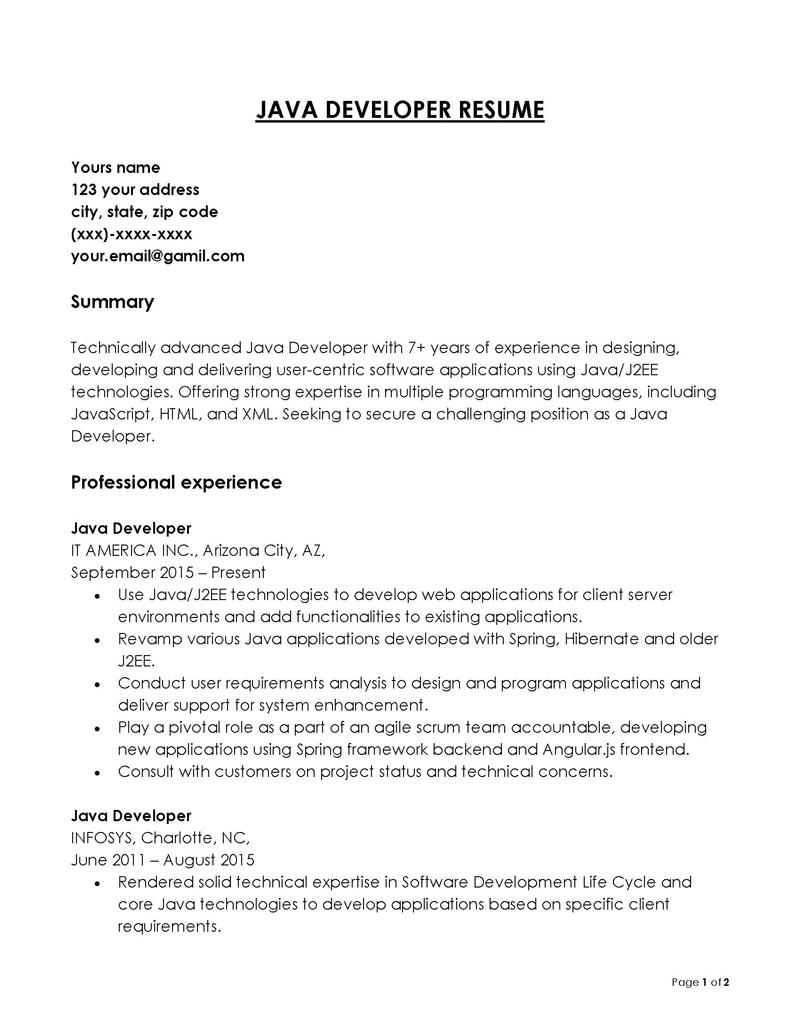

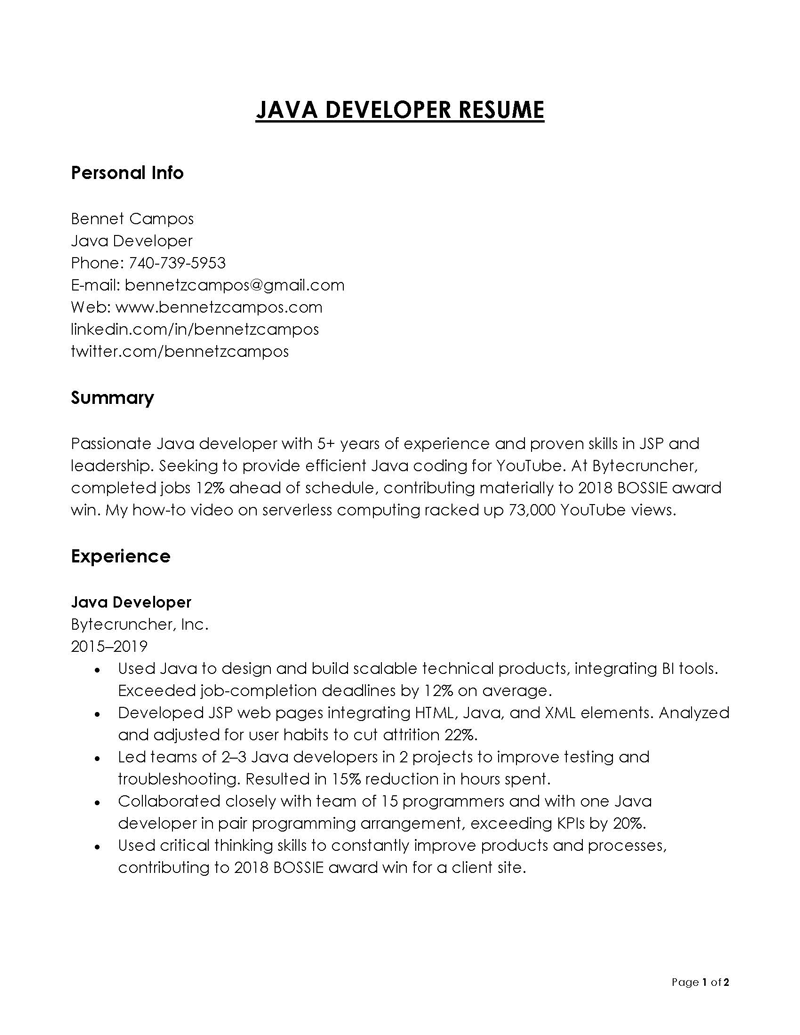
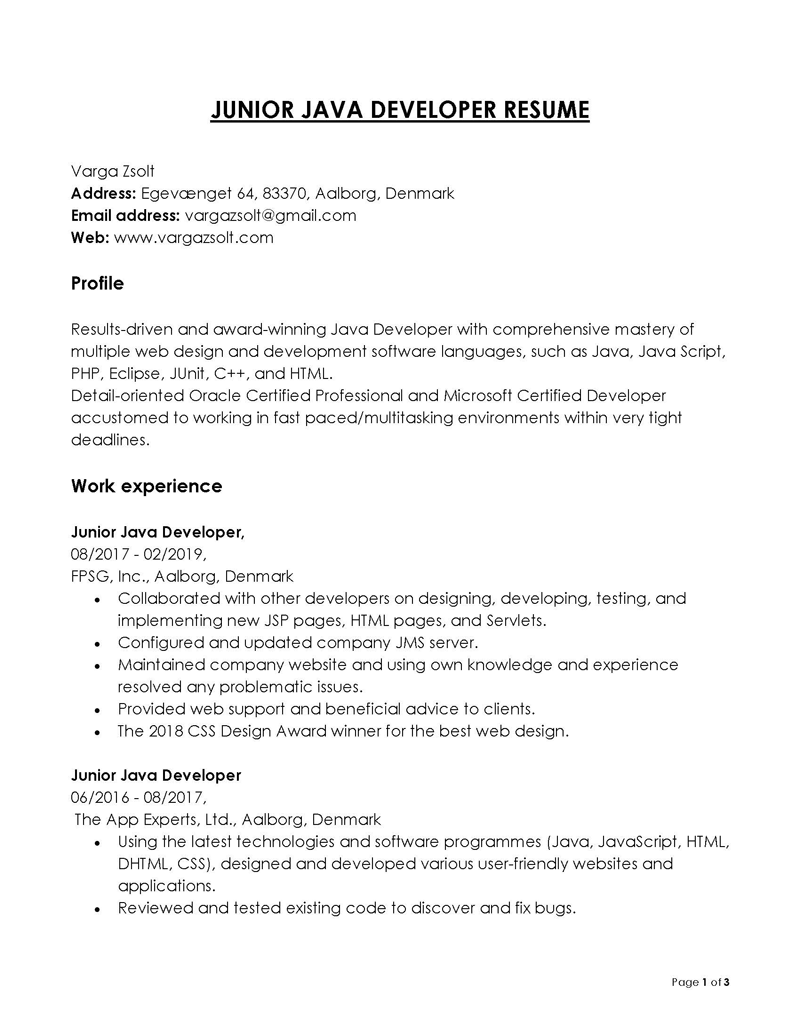
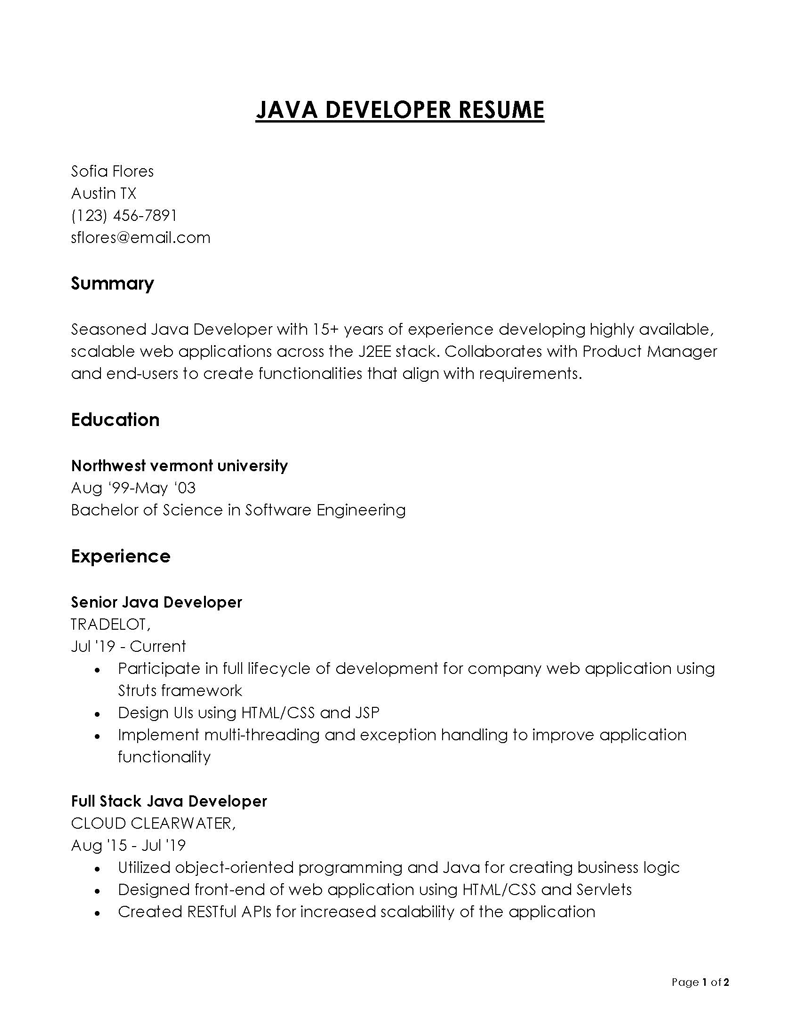
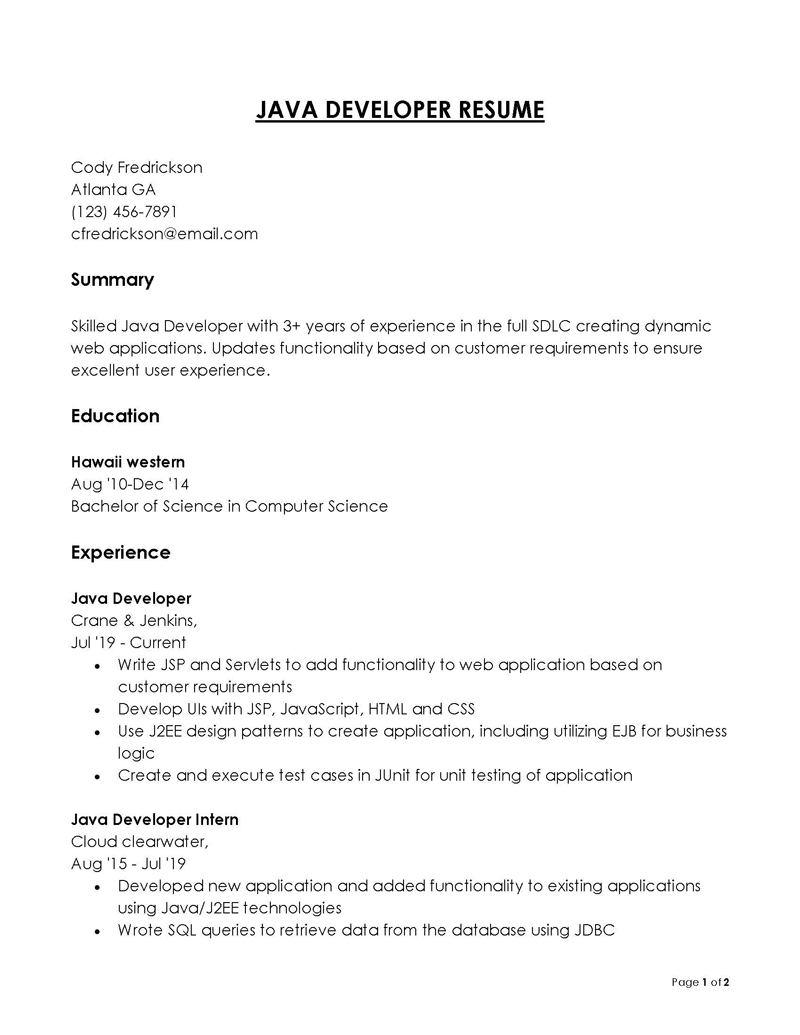
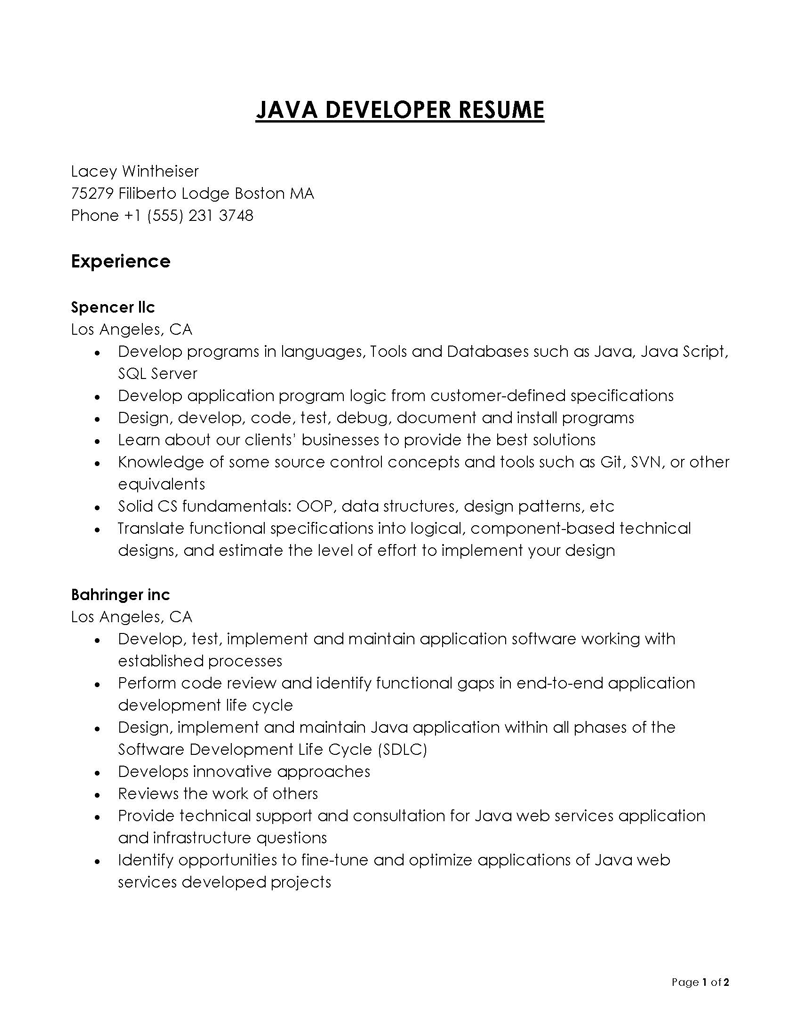
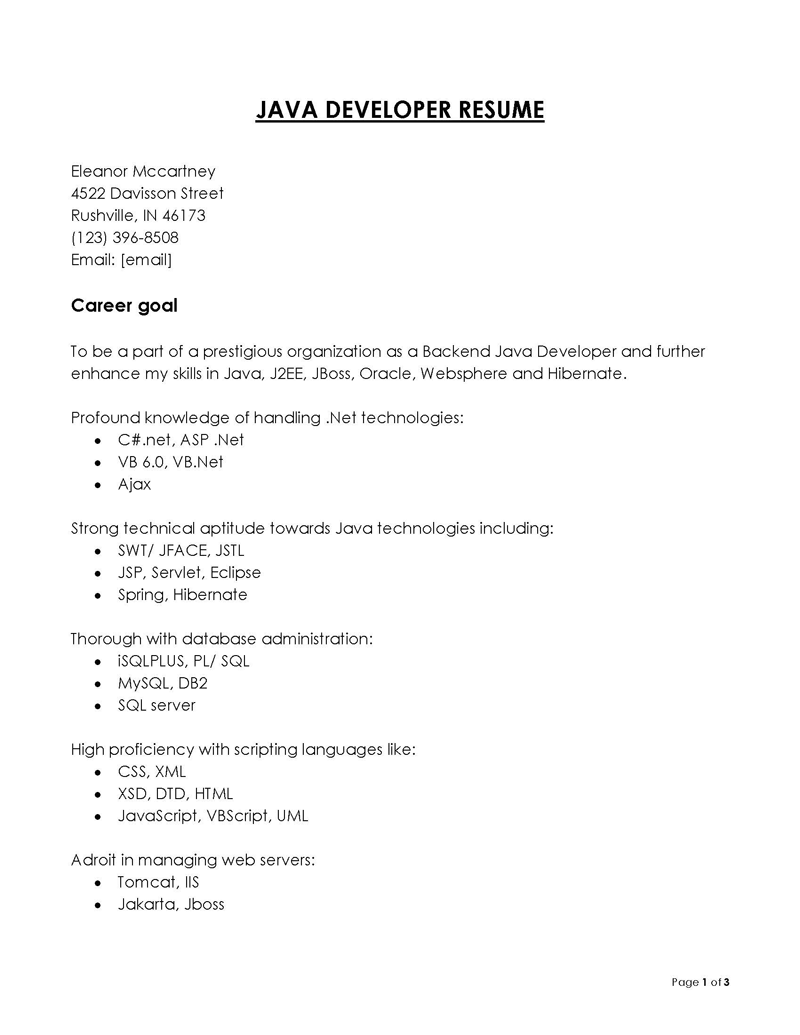
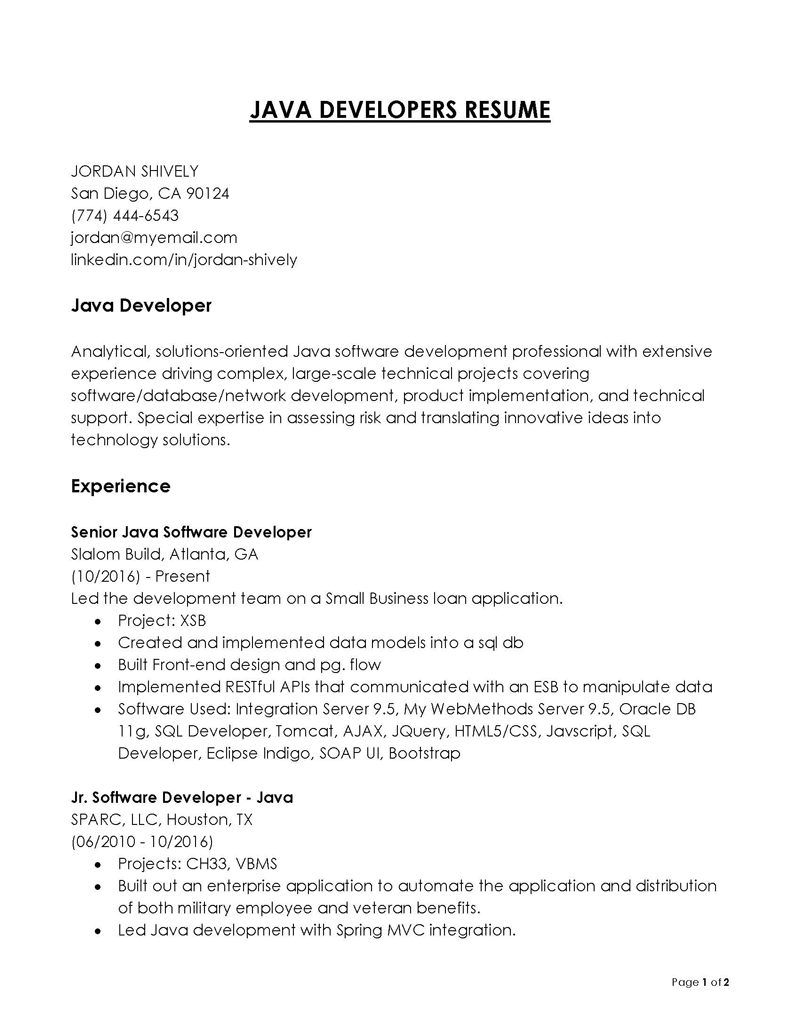
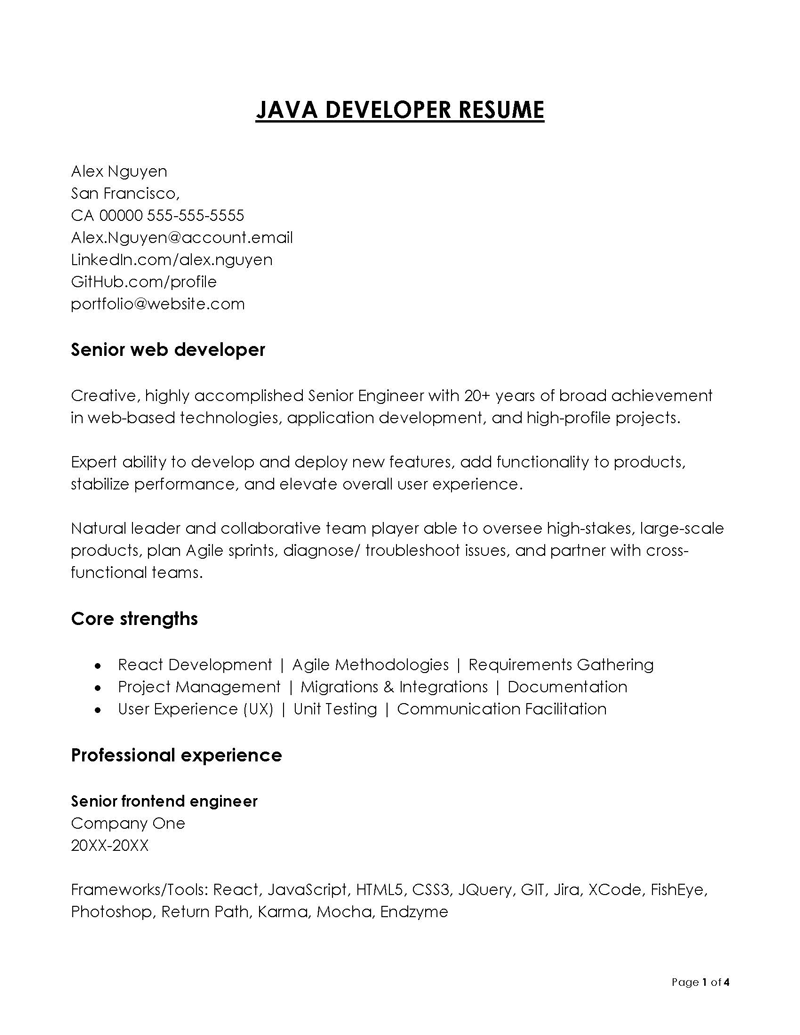
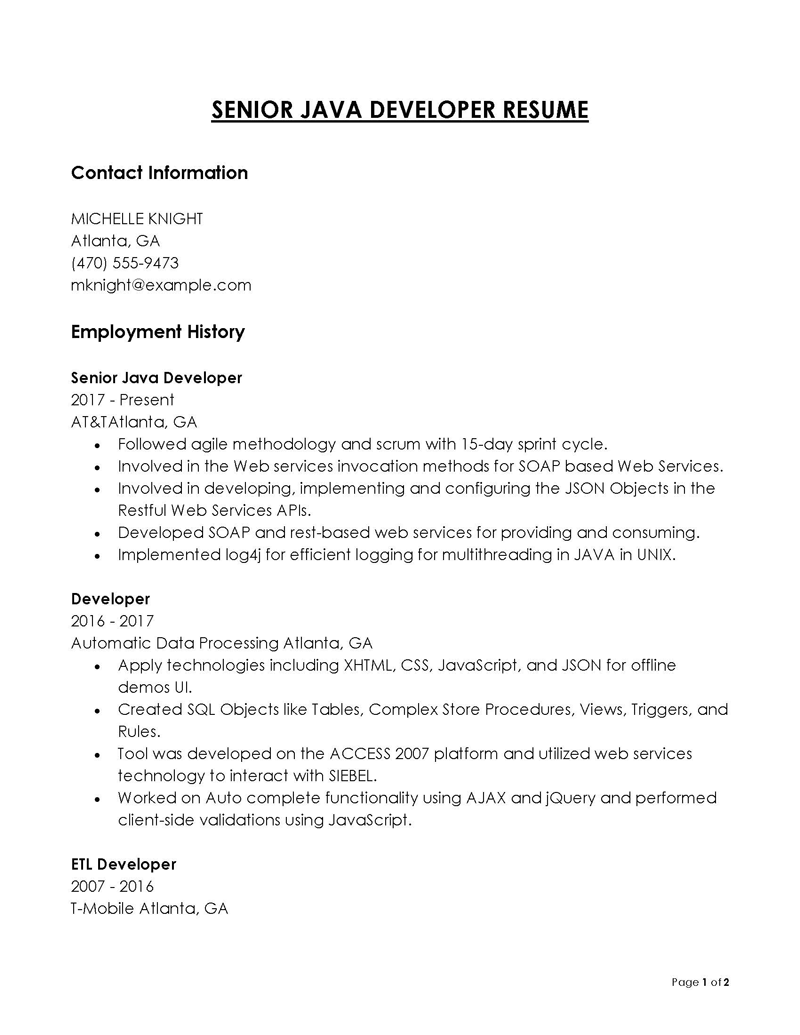
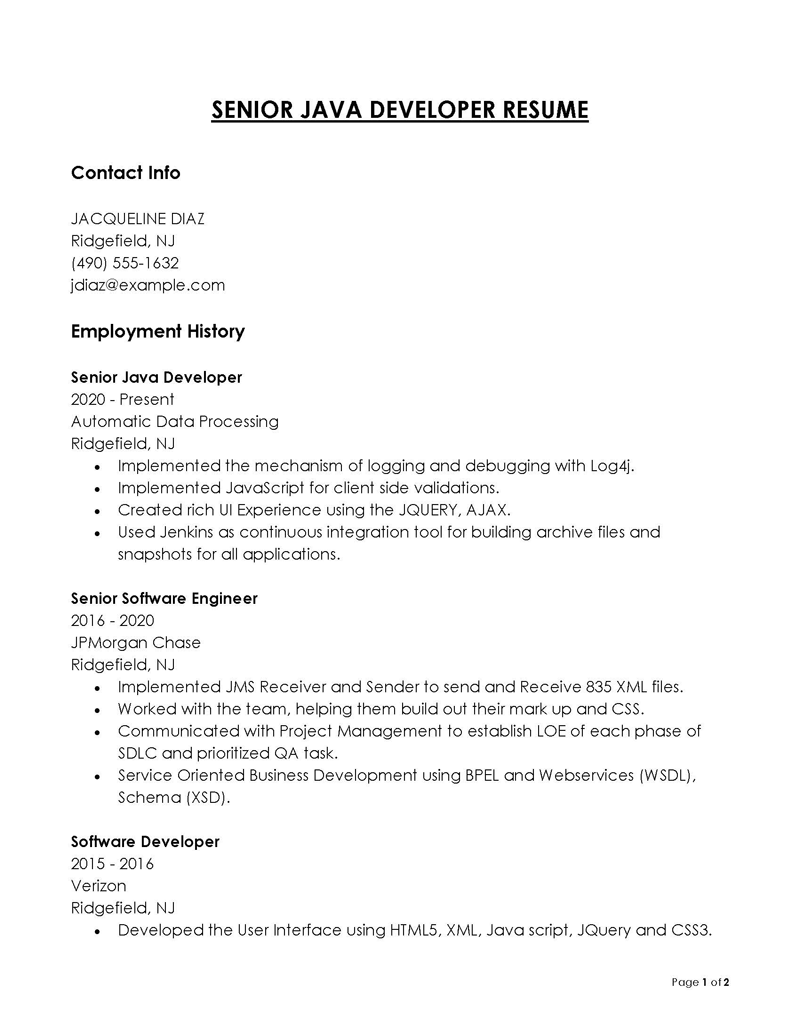
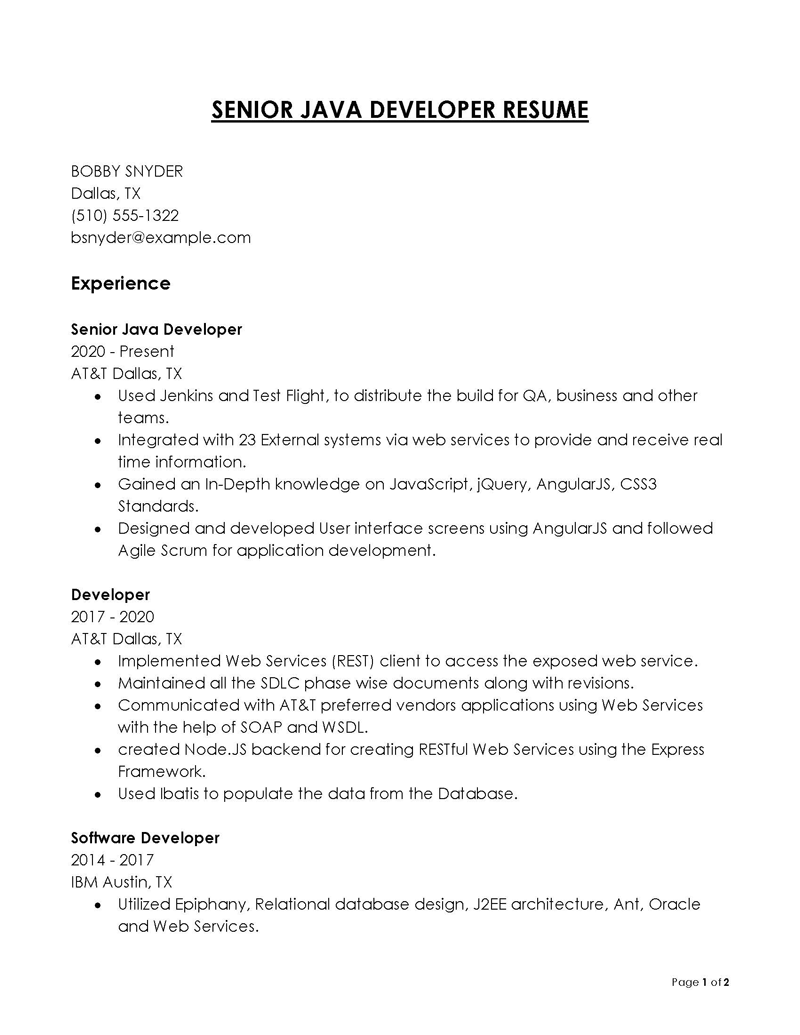

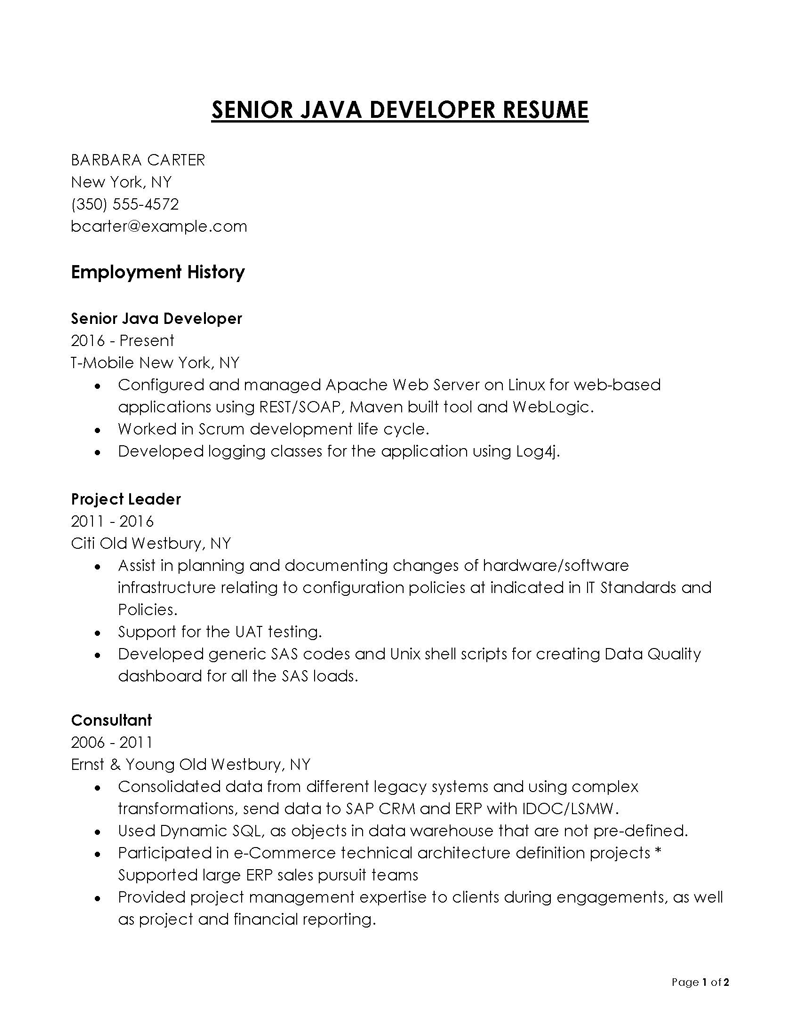
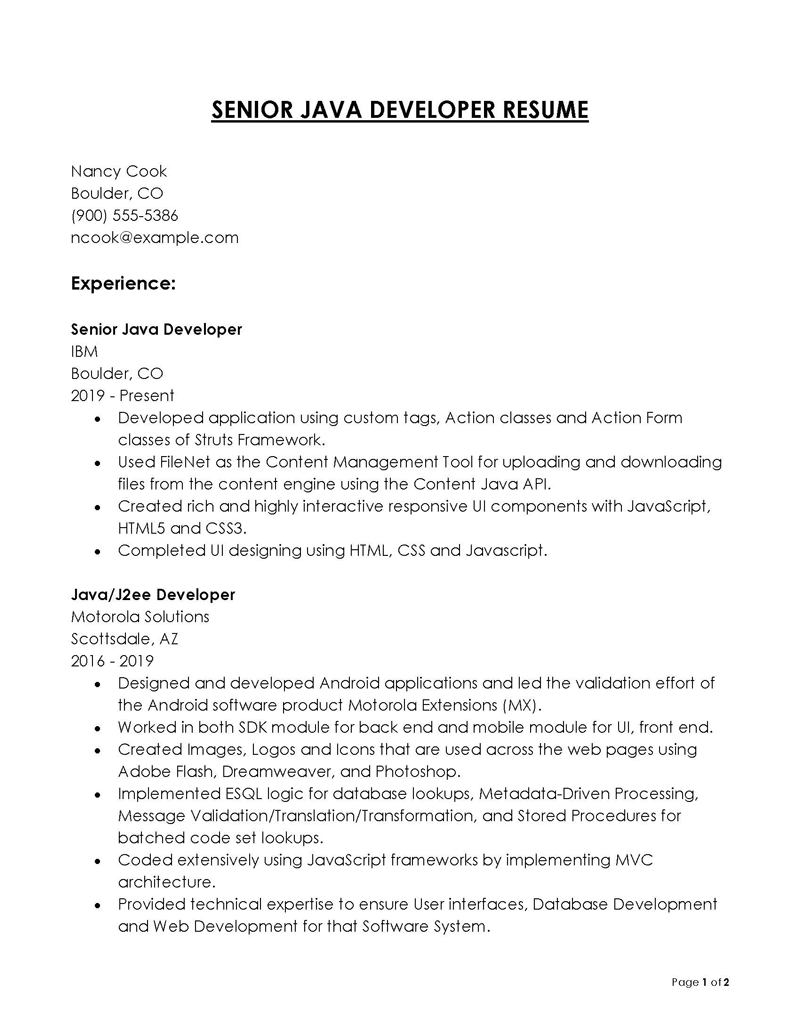
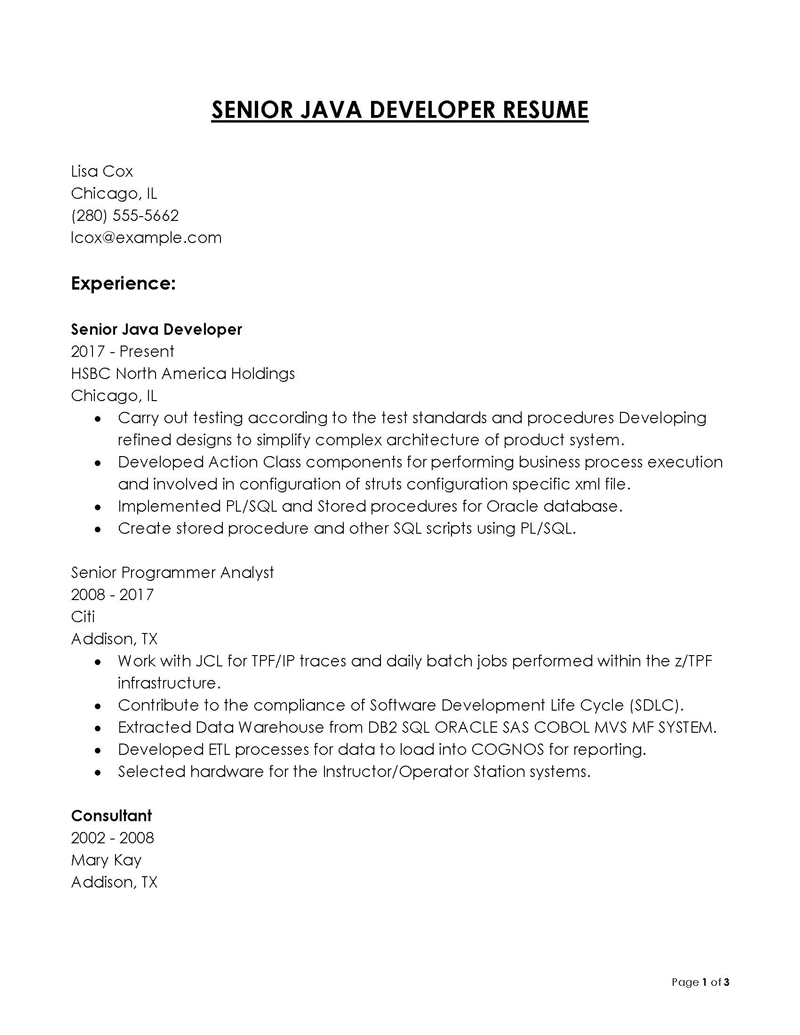
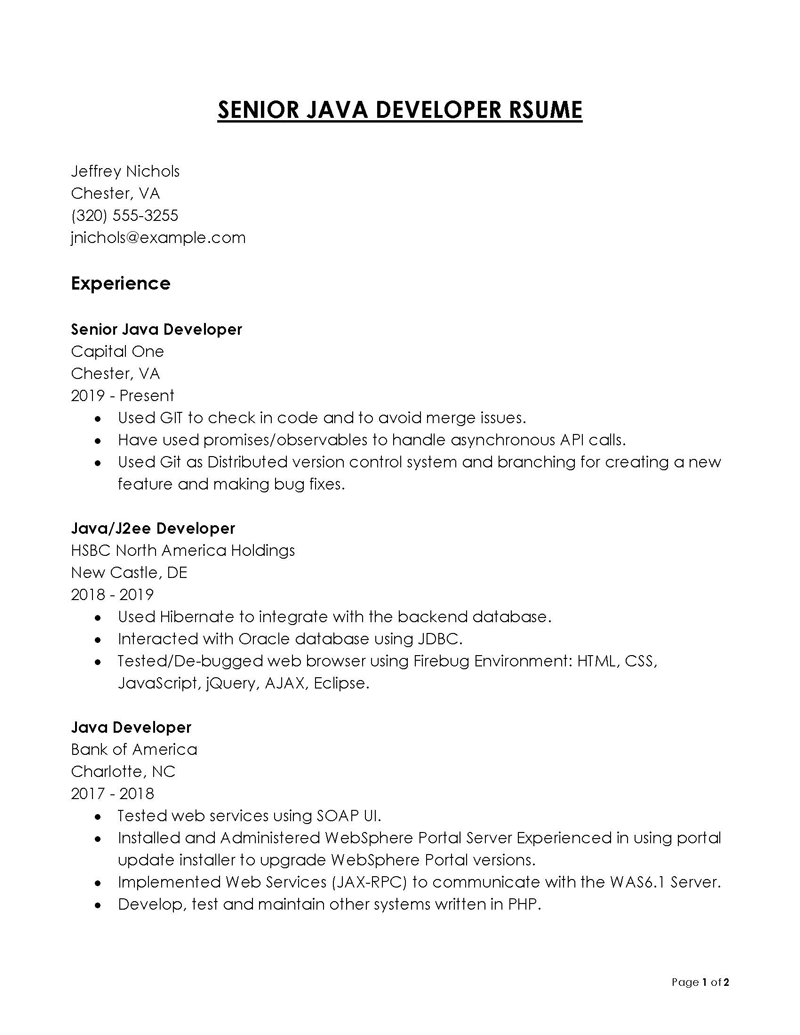
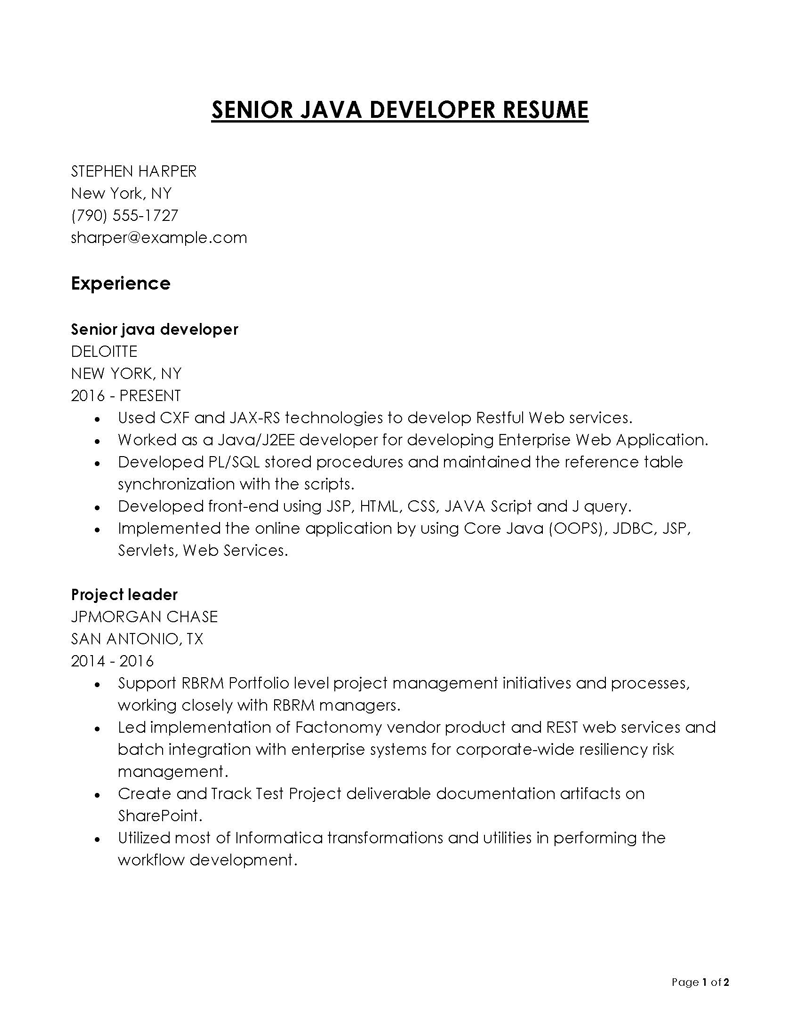

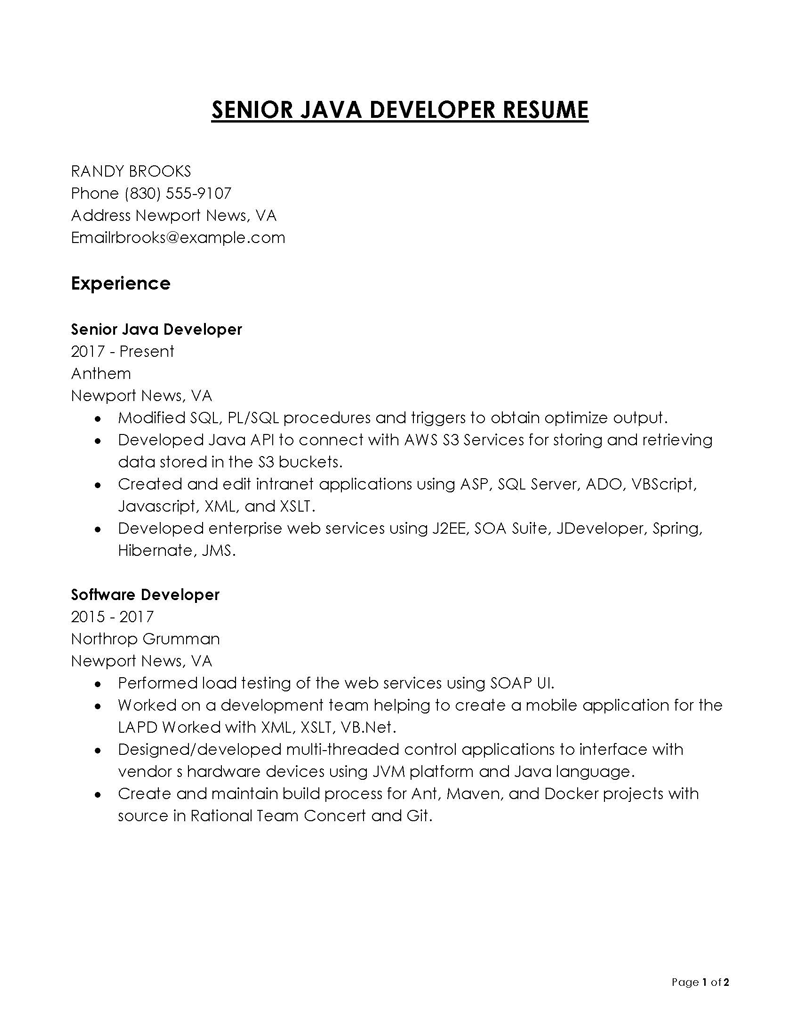

Strategies to Successfully Navigate Hurdles Presented by Applicant Tracking Systems (ATS)
The Applicant Tracking System, commonly known as the ATS, is designed to select applicants based on keywords. As a result, the potential employer will receive only applicants with well-formatted resumes and effective use of keywords. The algorithm works with patterns, so no matter how impressive your credentials are, it is possible that your application will not shortlisted.
By knowing how ATS systems function and strategically optimizing your resume, you can improve the likelihood of bypassing the ATS and reaching the hands of human recruiters for further review.
To give you the best chance at every opportunity, observe the following:
- Use margins; leave one spacing line between paragraphs, making the resume appear easy to read.
- Use only Arial, Calibri, and Times New Roman fonts in sizes 10-12 points.
- Bold all headers to distinguish them from the rest of the text.
- Ensure at least three related keywords are relevant to the job when listing skills.
- Use a reverse chronological format where jobs are listed from latest to oldest.
- Everything should be aligned to the left, making it both presentable and easy to read.
- Employers do not have time to read multiple pages, so keep everything on a single page.
The Do’s and Don’ts for the Writing Process
When writing a resume, there are a few things to remember:
The Do’s
The do’s:
Quantify your achievements
Numbers matter a lot and help put your achievement in context, making it more impressive to employers. Quantify your achievements to make yourself stand out among other applicants.
EXAMPLE
I developed a script that improved website efficiency by 60% and user interaction by 40%.
Include keywords
Employers and the ATS frequently search for keywords and can disqualify you if they do not find any. Always include a few keywords that are related to the job.
EXAMPLE
- Java
- Computer Science
- JavaScript
- SQL
- Database
- Software Development
- Software Engineering
- J2EE Web Services
- AngularJS
- Amazon Web Services
- User Interface Design
- Web Development etc.
Keep your resume concise
With many applications to sort through, most employers only spend a few seconds glancing through job applications. Therefore, ensure only relevant information is present, allowing the potential employer to instantly see relevant information.
Customize your resume for the job
Each resume you submit should be tailored specifically to the job in question. Always create a new one for each job, omitting irrelevant details and replacing them with relevant ones.
Include action verbs
Action verbs are positive words employers look for, especially when the position in question is to meet a specific need. Include as many action verbs as possible, especially when listing experience and past projects.
Some of the action verbs include:
- Improved
- Designed
- Developed
- Resolved
- Analyzed
- Evaluated
- Produced, etc.
Proofread before submission
Typing errors and false information can make you look unprofessional or untrustworthy. In either case, you want to avoid any errors. As a Java developer, you must be precise, and your resume should demonstrate this. All information should be related to the job description. If possible, request someone else to review the document and highlight anything you might have overlooked.
The Don’ts
The don’ts include:
Don’t use negative phrases
Avoid using negative phrases, even when referring to problems with previous projects or employers. Instead, focus on the solutions or positive side of such occurrences.
EXAMPLE
You must write “improved efficiency” instead of “reduced inefficiency”.
Don’t overload your work history
You do not have to list every task you have been a part of, even if it is relevant to the job. Instead, choose the best tasks and accomplishments, making sure to keep the resume brief.
Don’t include irrelevant information
Do not include any information that is not relevant to the job in question, no matter how impressive it is. Including irrelevant information occupies valuable space that could be better utilized for more important details relevant to securing the job.
Frequently Asked Questions
Including references is generally not necessary. It is common practice to provide references upon request, rather than include them in the resume itself. This allows you to maintain the focus on your relevant skills, experience, and achievements.
If a potential employer specifically asks for references in the job posting or during the application process, you can prepare a separate document with your references.
There are a lot of certificates that relate to Java and are relevant for job opportunities. Some of these include:
Complete Java Masterclass
Complete Java SE 8 Developer Bootcamp
Oracle Java Certification
Java Certification: OCA (1Z0-808)
The use of keywords and buzzwords in your resume can be crucial, as it helps it be more easily discovered by the ATS (Applicant Tracking System) and also resonates with human recruiters who are looking for specific skills and qualifications. Review the job posting and identify relevant keywords, then include these keywords naturally.








